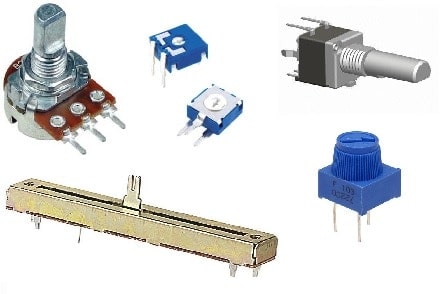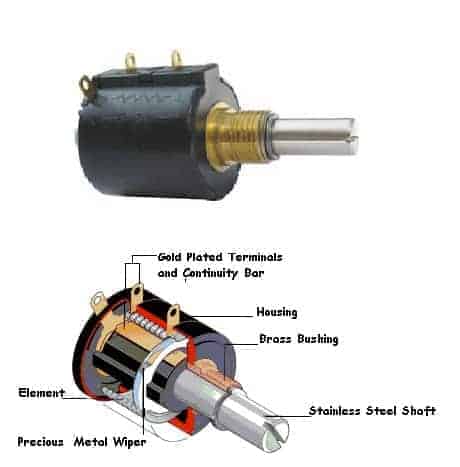Potentiometers are common electronics components that convert rotary or linear motion in to change of resistance. They can be found anywhere where some adjustments are needed, volume control, and joysticks. You can dive into the long theory about potentiometers, how they are made, what materials are used, and what output characteristics they have regarding rotation angle.
As an electronics hobbyist and probably pro, you usually deal with two common types of potentiometers – standard pots with knobs and trim potentiometers. The first group of potentiometers is used where the user has to access the potentiometer when he needs to change one or another parameter like sound volume or screen brightness. They usually are more prominent in size and can be mounted vertically or horizontally to board. Also, they have a panel mount with the nut. This type of potentiometers needs to be mechanically stronger and resistive material more durable due to frequent use.
On the other hand, Trim pots are much simpler in construction as they are used rarely during system setup to fine-tune parameters. They are small in size, so they are convenient to mount on PCBs. They aren’t normally accessible to the user – only when servicing.
Speaking of potentiometer characteristics – the most common are three: Linear – when resistance changes linearly over a full turn. In audio applications, you can find logarithmic potentiometers, and the third group is known as antilogarithmic. Of course, you probably can find different characteristics as well.
Potentiometers aren’t rated for high power applications. They stand before control circuits. With a standard potentiometer, you cannot drive heavy loads (except rheostats). So it would help if you kept in mind that there are limits. Depending on the material, these limits vary but are up to 0.5W. If you have doubts – Ohms law will help.
The last thing I want to touch on about pots as resistive material. Many materials are used, but the most common is carbon, which is cheap and of good quality for most purposes. It has a long life and moderate noise level when speaking of audio applications. Other materials are Cermet (ceramic and metal composite). They are of better quality than carbon, with a lower noise level and higher stability. They are commonly used in trim pots due to the limited number of operations. Other materials are based on conductive plastics that give great characteristics — mostly found in audiophile applications. And of course, let’s not forget wire-wound potentiometers that generally are used in higher power applications. They are much lower precise with granular resistance steps due to wire windings.
If you need a very precise potentiometer, then one of the best options is to use multiturn precision potentiometers. As their name states – you need to do a few knobs turns to go through scale. There is no big magic inside such potentiometers – usually, a screw mechanism is used to slide the wiper. The more turns the potentiometer needs, the more precise values you can set. You can find different multiturn resistors that reach over 25 turns for very fine-tune applications.
Let’s take a look at one multiturn resistor example found on Rapid electronics. As an example, we can pick a 5-Turn Precision Potentiometer used for panel mount. Bourns has manufactured it. It has been developed for both – human-machine (HMI) and machine to machine interface (MMI). The case can withstand a heavy rotation load while maintaining parameters within specs. This type of potentiometer is built using wire-wound technology and Hybritron (conductive plastic coated wire wound). Their tolerance is about 3% and linearity 0.25%. Life-cycle is rated 1 million shaft revolutions. With five turns, you can get exact values of resistance. Say you have a 1k potentiometer. So in one turn, resistance change is 200 Ohms. So for the one-degree angle, you can step about 0.555 Ohms. If you mount the servo mechanism to such a potentiometer, you can get an even better resolution.
As you can see, multiturn potentiometers can be used for really finetuning applications. The more turns it has, the more precise resistance can be set. Multiturn potentiometers are great for measuring angles, distances, and rotations. Other uses are tuning equipment of medical and industrial equipment. Also, they are extensively used in scientific and measurement instruments.







